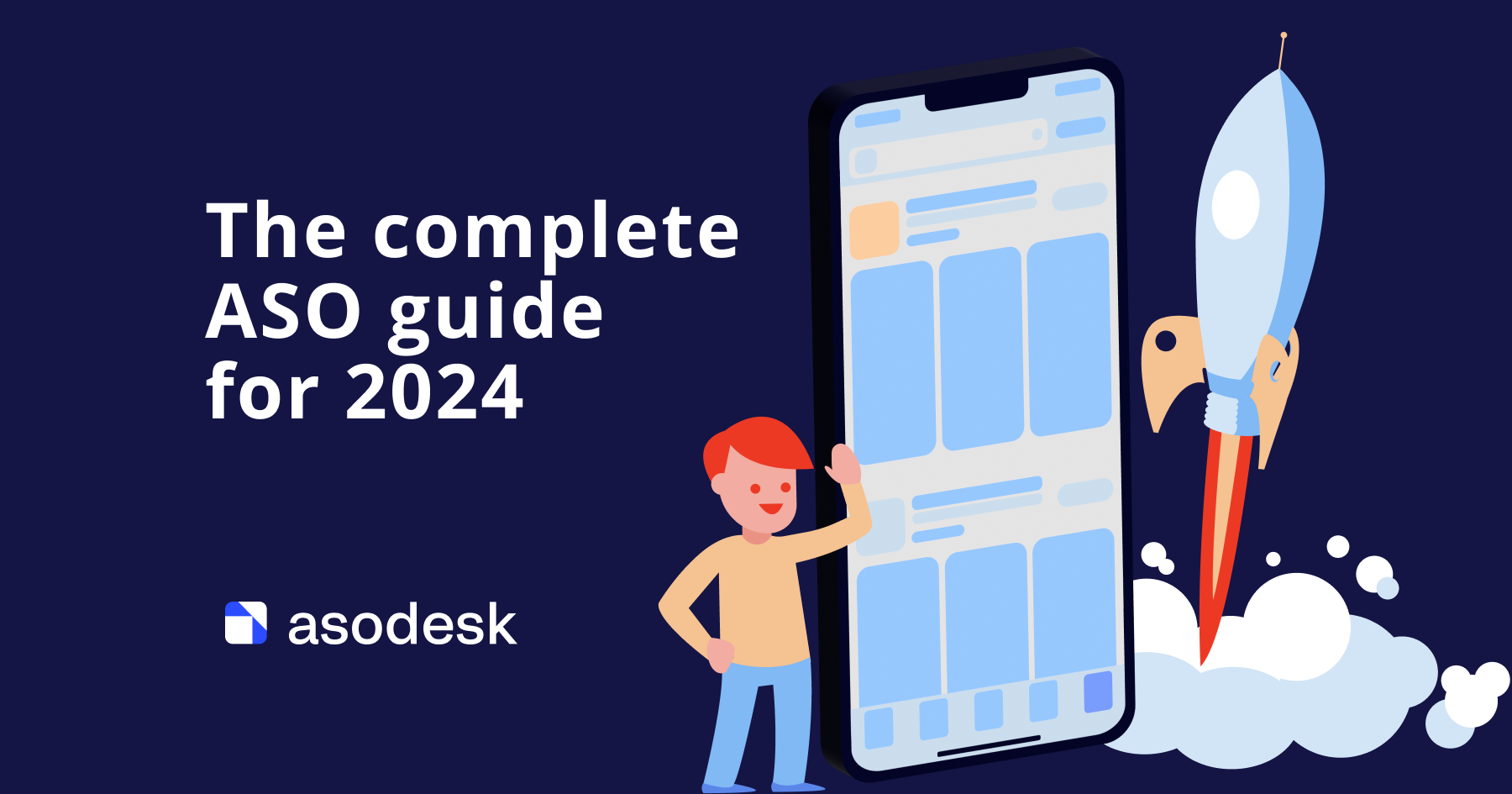ASO vs SEO: how SEO specialists can master ASO quickly

If you are an SEO specialist who has been asked to conduct App Store Optimization (ASO) for a company, this article is for you. In this article, we discuss how ASO can help businesses, what the difference between ASO and SEO is, what ranking factors are important to consider when optimizing, and how one can quickly master all 8 stages of ASO.
Contents
What is ASO and how can it help businesses
ASO vs SEO: what are the similarities
What are the differences between ASO and SEO
How to master ASO quickly: 8-step guide
What is important to remember for an SEO specialist who starts doing ASO
What is ASO and how can it help businesses
If your business has both a website and an app, you need App Store Optimization (ASO) to attract organic traffic. ASO is the process of optimizing an app to improve its visibility and optimize conversions in app stores such as the App Store, Google Play, etc.
ASO helps you boost your app to the top positions in the stores, which will make it possible to attract installs from the search. Keywords in your apps’ text metadata will help you promote them to higher positions in the search results. An attractive app page also motivates users to download it from search.
Here are some examples of how ASO can help businesses:
1. Increase installs from the App Store and Google Play

Timur, ASO Manager at ABBYY

Working with ASO helped us increase installs for the Business Card Scanner app in Japan by 15 times.

Andrey Moroz, CEO of Aloha

From the moment we started doing ASO systematically, organic traffic has grown by 4 times in the App Store and 2.5–3 times in Google Play.

Daria, ASO lead at Domini

Changing text and visual metadata helped increase our number of installs from search by 425% for the game Mystery Tales 5 f2p.
2. Improve the conversion rate of your app page in the App Store and Google Play

Anna, Head of ASO at DEVGAME

Thanks to ASO, we achieved our highest conversion rate from search in the project “Blue Tractor: Games for Kids” on the App Store — 61.20%.

Daria, ASO lead at Domini

Thanks to working with ASO, we increased the average install conversion rate for our games to 40%.

ASO vs SEO: what are the similarities
ASO is often referred to as SEO for mobile apps. ASO and SEO do have some similarities that are worth considering while optimizing apps:
1. Keyword optimization plays an important role in SEO and ASO
You need to find the right keywords that will be taken into account when indexed by search algorithms. To promote keywords in SEO, specialists insert them into titles, meta tags, and text on the site, make micro markups, and hierarchize all pages in the sitemap.
To optimize your app, you need to add keywords to the metadata that is indexed by the App Store and Google Play algorithms. On the App Store, this metadata includes the title, subtitle, and keyword fields.

On Google Play, indexable metadata includes the title and a short and full description of the app. The title has the greatest impact on indexing in both the App Store and Google Play.
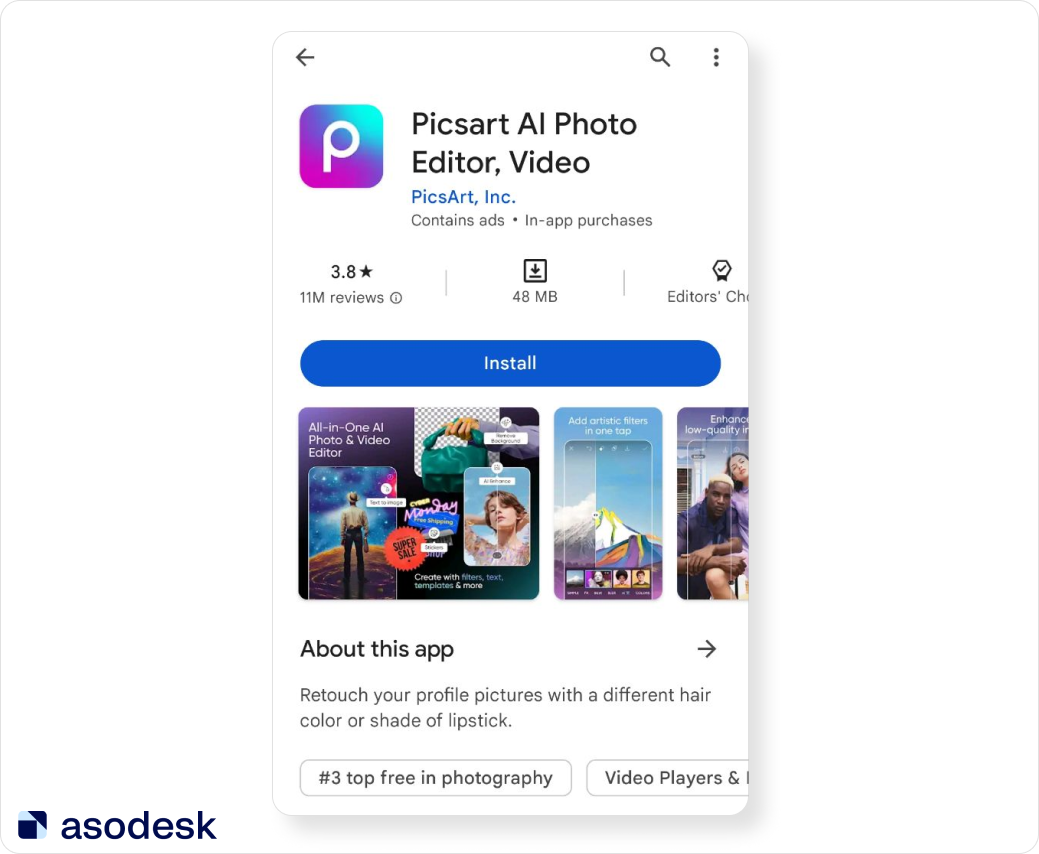
However, it is important to note that in the ASO process, we are more limited in the number of characters for different metadata fields. In SEO, you can create a 100-character title, although this will negatively affect optimization. With ASO, you cannot go beyond the character limits, as they are limited by the App Store and Google Play.
In the image below, we show the limits for different metadata fields.
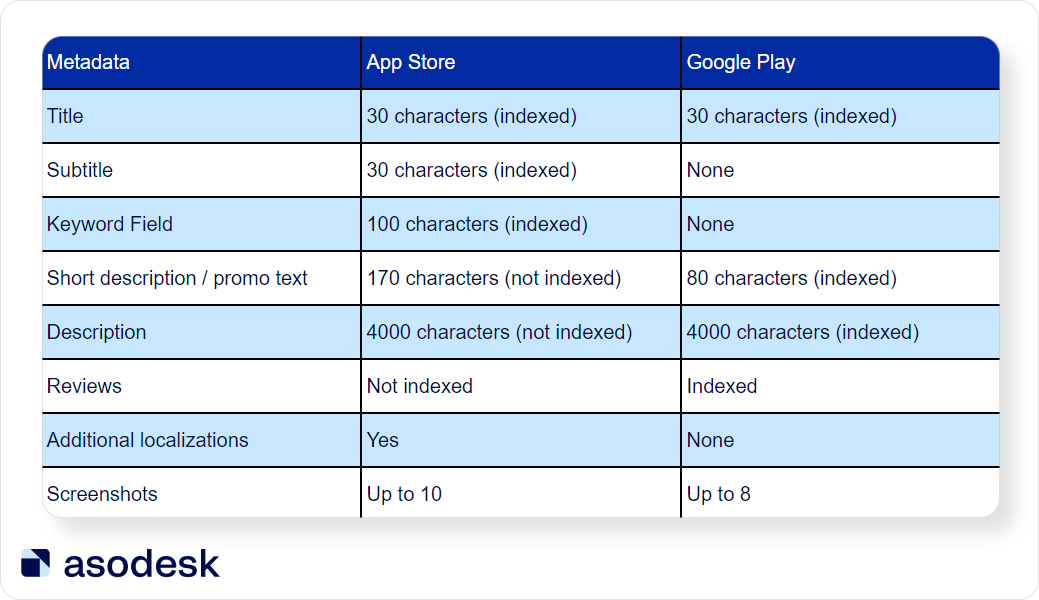
2. User experience affects both the position of your site and your app
When your site is indexed, the relevant factors are usability and page load time/speed. An app’s position in the search results is affected by the volume of installs: the more users download an app, the higher its position on the App Store and Google Play.
The frequency of launching and deleting an app is considered in Google Play ranking. Therefore, it is important that those who download your app have a positive experience using it and want to visit it more often.
With SEO, a site’s position in the search results and bounce rate are affected by its load time. While in ASO, the number of installs is affected by the size of the app as users often decide in favor of smaller apps.
3. Stages of optimization
Despite the obvious differences in the optimization process, ASO and SEO have similar stages. Here are the stages of ASO, which are similar to the corresponding stages of SEO:
- Collecting a semantic core. At this stage of ASO, it is important to find all possible keywords and save them for further optimization. Just like SEO, with ASO you will need dedicated platforms that help you find and collect all the necessary keywords.
- Preparing metadata. With SEO, it is important to create a title and description for each page of the website. With ASO, you need to prepare a title, subtitle, short and full description, icons, and screenshots for an app page.
- Measuring the effectiveness of ASO. With both SEO and ASO, it is important to regularly monitor the effectiveness of optimization.
- Working with iterations. With ASO and SEO, it is not enough to conduct optimization just once. You need an iterative approach, and it is important to do several optimization cycles in order to achieve the best results.
- Searching for growth hypotheses. In SEO and ASO, it is important to test new hypotheses that will help you gain more installs from search or improve conversion from your app page.
- Tracking keyword statistics. In ASO and SEO, it is important to regularly monitor app positions in order to promptly detect changes and adjust your strategy.
- Competitor analysis is a significant step not only in SEO but also in ASO. You need to analyze which keywords are used by your competitors and how they choose the title, description, icon, and screenshots for their apps. These insights will be useful for your strategy.
So, some of the principles that work in SEO are applicable in ASO as well. App Store Optimization has a number of stages that are similar to SEO. With SEO and ASO, it is important to pay most of your attention to working with keywords and improving the user experience.
What are the differences between ASO and SEO
Despite some similarities between SEO and ASO, these promotion methods have a number of obvious differences that are important to consider in your work:
1. Ranking algorithms
SEO ranking factors include page optimization, keywords, backlinks, content quality, user engagement signals, site speed, and ease of use on mobile devices.
ASO identifies other factors that affect the app’s position in the search:
1. Use of keywords in metadata. App Store and Google Play algorithms scan keywords on your app page and index your app for similar search queries.
2. The overall volume of app installs. This will take into account not only app installs from the App Store and Google Play search, but also any installs from paid channels.
3. Revenue. This parameter has a greater impact on the ranking of paid apps.
4. Frequency of app launches. If users do not uninstall the app within 2–3 days after installing and launching it, it will have a more positive impact on rankings than a regular app install.
5. Rating and number of reviews. The more positive reviews your app has, the higher its position in the search results will be.
6. Recent update in the App Store. After a release, your app will get a boost in the search results. This is how the App Store helps new versions of an app gain more users.
7. Deletion of apps on Google Play. The more often an app is deleted after installation, the lower its ranking will be.
8. Backlinks (Google Play). Google takes backlinks into account not only when ranking sites, but also when ranking apps. If your app has a large number of links on trusted websites, its position on Google Play search will be higher.
9. Developer name (Google Play). Google ranks your app not only for search queries in its metadata but also for queries that include the developer’s name. App publishers in forums note that changing the developer’s name can lead to a decline in app installs.
10. Link to the app (Google Play). Keywords in the app link can positively affect your app’s position in the search results. Therefore, it is important to use search queries that have traffic in your app link.
11. Names of in-app purchases (App Store). In-app purchases on the App Store allow you to sell products, subscriptions, and premium content directly on your App Store app page.
In-app purchases are indexed by App Store algorithms, so it is important to use relevant keywords in their names and descriptions.
2. Optimization techniques
SEO has many more technical factors that need to be optimized to successfully rank a site in the search: site content, meta tags, URLs, titles, images, and backlinks.
In ASO, the main objective is to optimize the app page: title, subtitle, keywords, icon, and screenshots.
The quality of the app itself is also important, but its improvement is not part of the ASO specialist’s work, but the work of developers. In order to rank in the top positions in stores, you should also work with reviews and app ratings.
3. Instruments
ASO and SEO use different tools and metrics to optimize and measure their effectiveness. SEO uses platforms for Search Engine Optimization of sites, such as Google Analytics, Ahrefs, or Moz. They allow you to find keywords, analyze site traffic, track keyword positions, the number of external links, and bounce rates.
ASO uses other platforms, such as Asodesk, to find keywords for the app, analyze competitors, track app positions in the search results, monitor the number of installs and conversion rates, analyze ranking changes and the appearance of new reviews.
4. KPIs
Some of these KPIs in ASO are similar to KPIs in SEO. For example, in SEO, it is also important to track site visibility in search, attendance, and conversion. But unlike SEO, KPIs in ASO are not related to technical metrics such as site load speed, session time, page depth, etc.
It is important for ASO specialists to track changes in app visibility, installs from search and other sources, positions on top charts, and editorial collections of stores.
In this sense, ASO cannot be reduced to “SEO for mobile apps”, since ASO has a number of specific features. To create an effective ASO strategy, it is important to take into account these ASO features: ranking factors, differences in optimization techniques, and necessary tools, as well as specific KPIs.
How to master ASO quickly: 8-step guide
ASO is conducted according to a certain system and has several stages:
1. Collecting a semantic core
You need to collect all keywords that can draw traffic to your app.
First, write down all the queries that you associate with your app. This is a very important stage: you shouldn’t proceed to further steps without it. You need to designate all possible keywords that correspond to the functions, competitive advantages, and USP of your app.
Then it is important to collect automatic ASO service suggestions. On Asodesk, you can find the most popular keywords for your app, keywords with the least competition, keywords of your competitors, queries for which your app is already ranked in search, and long-tail queries.

If your app is just entering the market, it will be difficult for you to rank for popular keywords. This is why we advise you to pay attention to long-tail keywords, keywords with average popularity, and keywords that are rarely used by your competitors.

In addition to automatic ASO service suggestions, you should also check each app store’s suggestions. These are the suggestions that appear under the search bar when you enter a query in the App Store and Google Play. Users often click on them to save their time.
Search Explorer on Asodesk will show you search suggestions for the required keywords. For example, on the right, you can see search suggestions for the query “workout”.
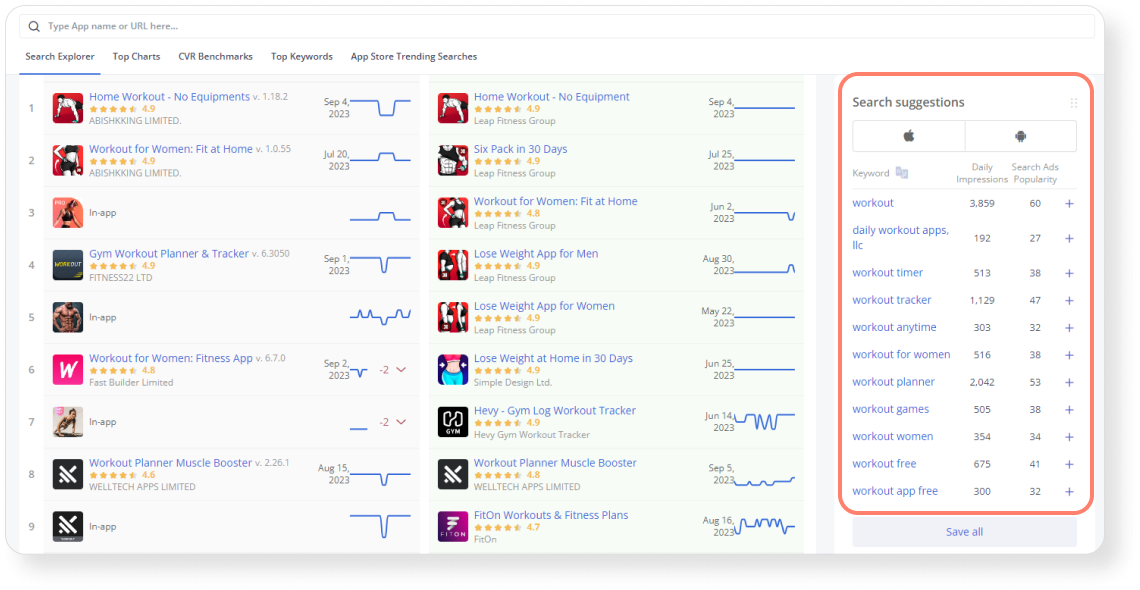
All keywords should be added to one table in order to track changes for them in the future.

After collecting the semantic core, it is important to go through the keywords from the table and delete irrelevant queries or keywords with a very low frequency. Read step-by-step instructions on how to build a semantic core in our article.
2. Preparing metadata
At this stage, we need to compile the title, subtitle, description, and keyword field for the app page, icon, and screenshots or video if you are optimizing in the App Store.
If you are optimizing an app for Google Play, at this stage you need to come up with a title, and short and full descriptions, as well as create an icon and screenshots or video.
You need to insert keywords into fields that are ranked by store algorithms. We have indicated these fields in the image below.

The keywords that can attract the most traffic should be used in the title.
In the App Store, you should never repeat a keyword several times: this will not affect the indexing but will take up characters that could be used on other keywords.
To avoid missing important keywords, using unnecessary keywords, and repeating keywords in your metadata; you can use Text Metadata Builder. It also highlights stopwords that take up space in the metadata without affecting the ranking of your app in blue. The repetitions of keywords that should be avoided are highlighted in yellow.
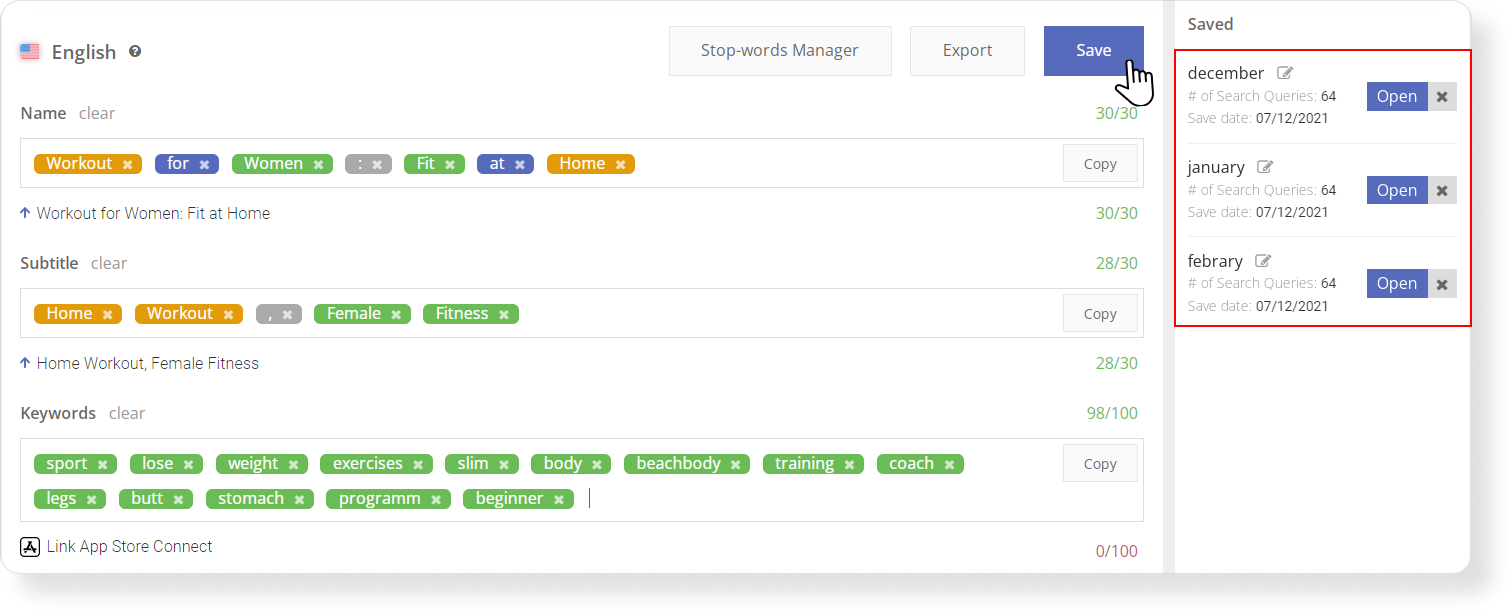
This report on used and unused keywords will show which keywords you have already added to your metadata, and which words from the semantic core you have missed.
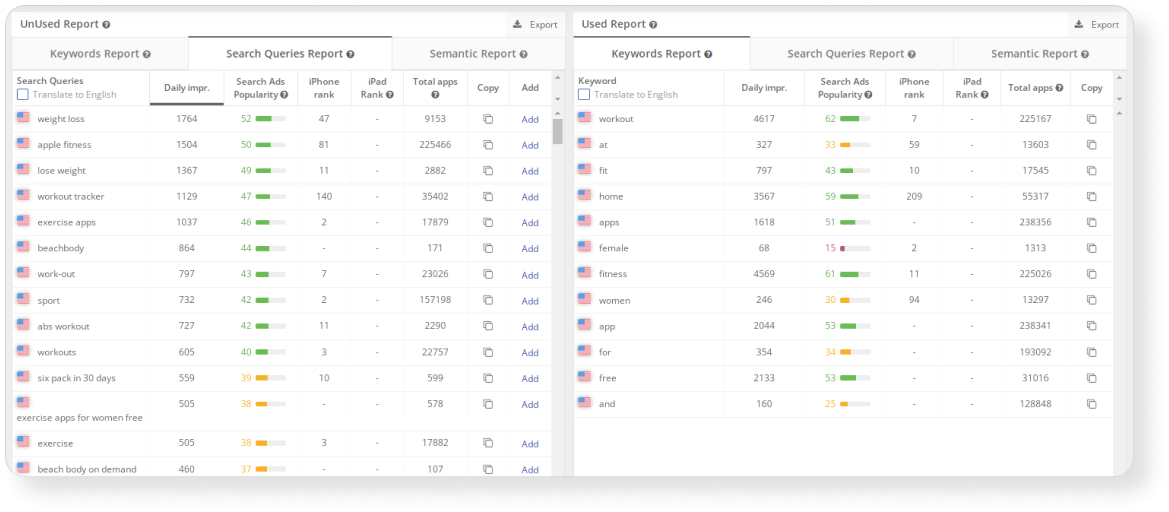
In Google Play, you can repeat important keywords in the description several times, so the algorithm will better index the app. It is important to focus on the density of keywords in the text: for important keywords, it should be about 3–4. In a 4000-character text for our client, we repeated a keyword over 12 times. Only once the keyword reached this number, it started indexing well.
You can check the number of repetitions and keyword density using Description Creator on Asodesk.

The title, subtitle, and short description of the app affect not only its ranking but also its conversion rate from the app page. This is why it is important that these fields are transparent to users and contain competitive advantages and USPs of the app. For example, in their short description, the publishers of Shazam talk about the app’s USP: the ability to find out song titles and discover concerts nearby.

Visual metadata (icon, screenshots, and video previews) can improve the conversion rate of your app page. An app icon should make it stand out from competitors in the search and at the same time be associated with the function of the app.
With the help of screenshots, you should tell users about the main functions or USPs of your app. For example, AdGuard publishers highlight the main advantages of their app in the screenshots.

You can also add one promo video for apps on Google Play and up to three videos for apps on the App Store. A video can tell users about the main features of the app and show how to use them.
To choose the best visual metadata for an app, it is important to study competitors, create several metadata options, and A/B test these metadata options.
Read more on how to create visual metadata for your app in this article.
3. Measuring the effectiveness of ASO
A couple of weeks after optimizing the app, you need to analyze the results and understand what should be corrected in your current ASO strategy.
To do this, you need to pay attention to the main KPIs:
Visibility of the app in search for specific keywords. If your work with keywords is correct, you will see an improvement in your app’s position in the search.

It is important to check not only the increase in popularity for all queries but also to assess the real visibility of your app in the context of <query popularity — app positions>. This will give you more objective data on how well your app ranks for popular queries.
The Semantic Chart in Asodesk will show your positions for keywords from in order of popularity.

App installs and conversion. The number of installs from the search is the main indicator that characterizes the effectiveness of your ASO. In addition to the number of installs itself, it is also important to track conversion from app page views in the store search (Impressions) and app page visits (Product Page Views).

You can also track app features and appearances in Categories and Top Charts. Featuring is getting a place in the editorial selection. To get into selections, effective optimization is not enough; it is important to fulfill a number of requirements from the App Store and Google Play.
Read more on how to track ASO performance in this Asodesk article.
4. Working with iterations
ASO needs an iterative approach since a single optimization will not bring tangible results. To get to the top of the App Store and Google Play search, you need to conduct ASO several times.
After each iteration, it is important to analyze the results of the last optimization and determine what should be changed in the next one. There are various types of iterations:
- Iterations for reach. Their main goal is to increase the number of search queries for which the app is ranked. If you’re just getting started with ASO, you’ll need a few iterations for the reach.
- Iterations to narrow the semantic core. Here we need to identify the search queries that have the greatest potential for app growth in search. It is important to understand which queries bring the highest number of installs and focus on them in your ASO.
- Iterations to maximize installs. In the process of these iterations, we need to improve the visibility of your app for the most relevant users. The number of queries for which your app will be promoted to the top positions of search results should increase.
Read more on how to manage iterations for your app.
5. Searching for growth hypotheses. At this stage, we need to find and test different hypotheses that will increase the number of installs and improve the conversion of your app page. Here are some examples of successful hypotheses that successful app publishers have implemented:
- Changing the standard icon to a summer theme helped DEVGAME triple its number of app installs within 3 weeks.

- Anastasia, ASO Lead at Belka Games, noted that adding a call for rescue (“Be the hero and rescue the townspeople”) to the description of their game increased conversion by up to 47% in their test.
Read the checklist that will allow you to find useful hypotheses for the growth of your app.
6. Tracking keyword statistics
An ASO specialist should regularly monitor an app’s positions for keywords in order to notice changes and correct the situation in time.
Using the Favorite Keywords tool on Asodesk, you can track changes in positions for the most important keywords, as well as check the top 5 apps for these queries.

You can also check which keywords the app started ranking for or lost positions for, and which words made your positions better or worse.

7. Competitor analysis
It is important to analyze competitors at every stage of ASO: when collecting a semantic core, preparing metadata, and searching for growth hypotheses.
You can find out which competitor keywords can bring you installs, how to make your app stand out from similar apps, and how your competitors’ positions have changed after their metadata was updated.
To find competitors who are ranking for your search queries, you can use the Live Positions tool on Asodesk. It shows the search results for the required queries and allows you to save competitors for further analysis.
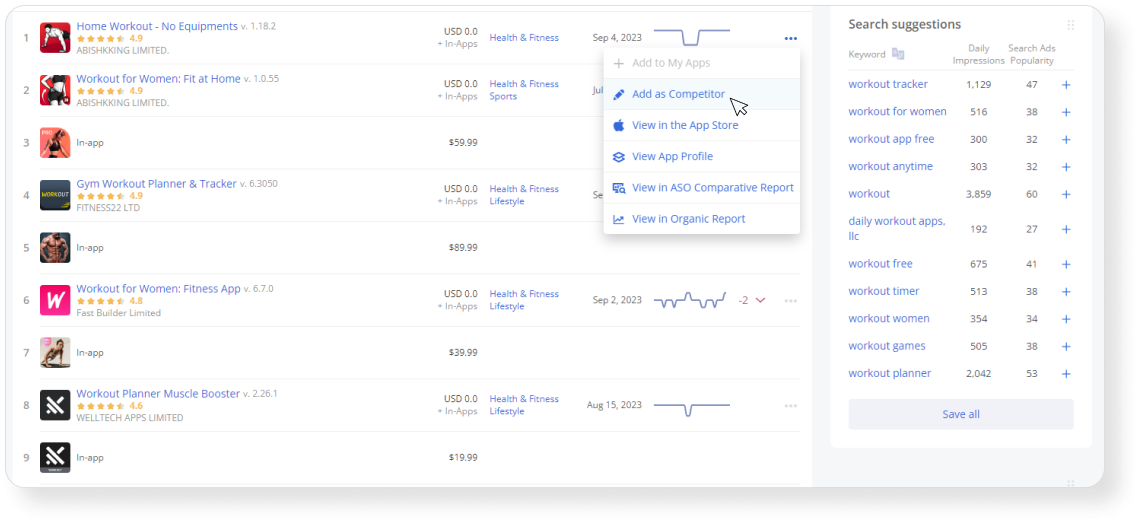
To find the most effective keywords for your app, you can check how many installs competitors receive from each keyword. You can do this using the Organic Report on Asodesk.

It is also helpful to track how the metadata and ranking of your competitors are changing. On Asodesk, you can do this with the ASO Comparative Report.

You need to create an app icon that will stand out from your competitors. To do this, it is important to analyze the icons of different competitors in the search results. You can do this using the Charts tool, which will show the top 10 apps for queries from your semantic core.
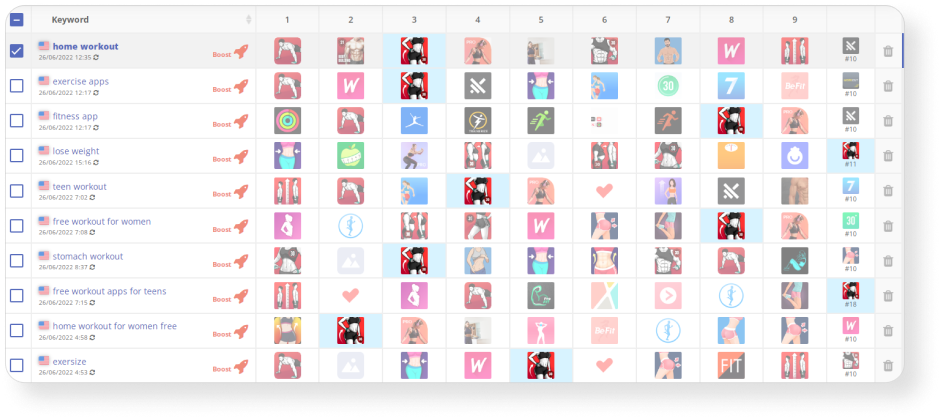
8. Localize your app
If you plan to promote your app in different countries, you need to adapt the app page to the local language, mentality, and culture. Learn how to localize your app for Japan, South Korea, and Indonesia.
What is important to remember for an SEO specialist who starts doing ASO
1. There are many similarities between ASO and SEO, and SEO insights will come in handy for your work. Working with keywords is important in ASO just like in SEO, and for a successful optimization result, you need to create a positive user experience.
2. There are many differences between ASO and SEO, and ranking algorithms in particular: the App Store and Google Play do not consider complex technical indicators, but pay attention to the volume of installs, keywords, the frequency of app launches, rankings and reviews, as well as some other factors we discussed above.
3. Use ASO tools to manage all stages of ASO. Just as effective SEO is impossible without special platforms, ASO cannot be performed without special tools.
Asodesk allows you to streamline every stage of ASO: collecting the semantic core, preparing metadata, measuring the effectiveness of ASO, working with iterations, searching for growth hypotheses, tracking keyword statistics, and analyzing competitors.

Subscribe to our newsletter and receive regular updates on App Store Optimization news, as well as informative articles covering ASO, mobile marketing, and app reviews management.




